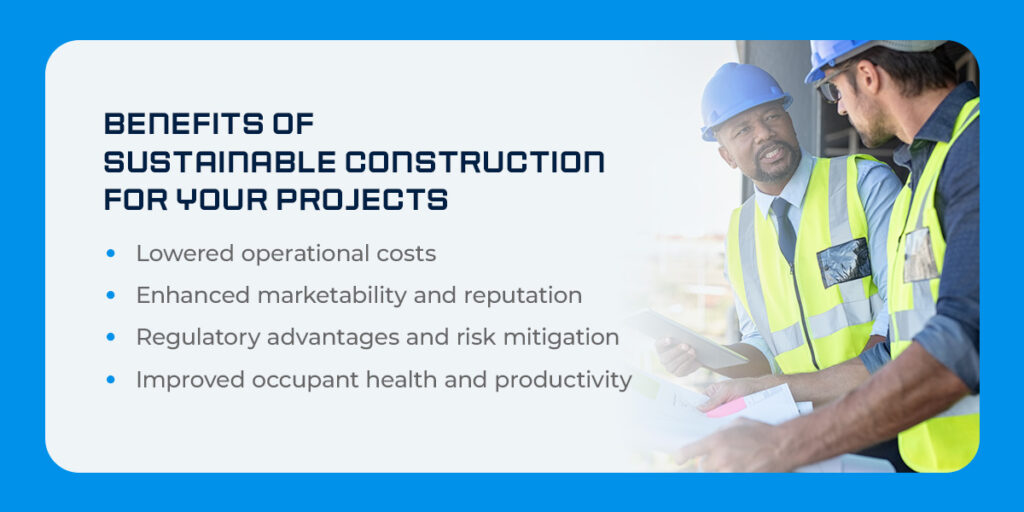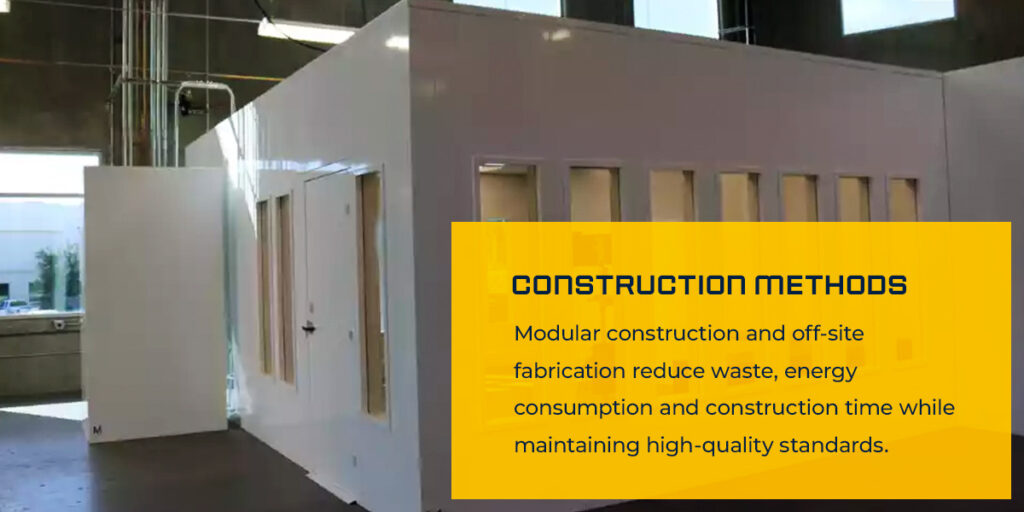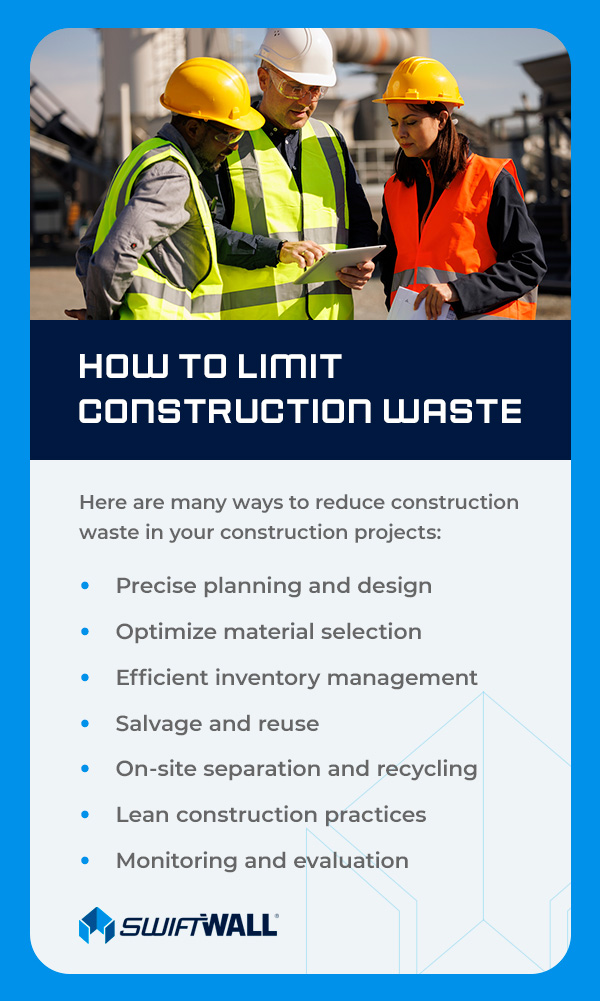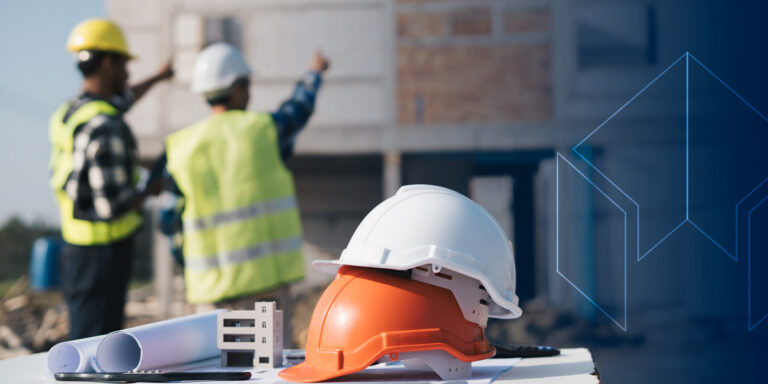Gone are the days when construction was solely about erecting buildings to meet functional needs. The discourse has shifted from merely constructing buildings to constructing resilient, efficient and environmentally friendly structures. The industry must now embrace a responsibility beyond profit margins by incorporating energy-efficient designs, eco-friendly materials and innovative construction techniques.
Below, we look into the reasons why sustainable construction isn’t just a trend but a fundamental shift that’s shaping the construction landscape.
Understanding Sustainable Construction
Sustainable construction goes beyond conventional construction practices. It centers on designing, constructing, operating and maintaining buildings to minimize environmental impact while ensuring optimal performance. This approach considers the ecological, social and economic dimensions of construction.
Key concepts and terms in this sector include:
- LEED Certification: Leadership in Energy and Environmental Design (LEED) is a globally recognized rating system created by the United States Green Building Council (USGBC) that evaluates a building’s environmental performance. Achieving LEED certification demonstrates a commitment to sustainability and energy efficiency.
- Life cycle assessment (LCA): An LCA evaluates the environmental impact of a building or product throughout its entire lifecycle, from raw material extraction to manufacturing, use and disposal. This approach helps identify areas for improvement and guides decision-making toward more sustainable choices.
One common misconception about sustainable construction is that it’s more expensive than traditional methods. While it’s true that upfront costs can be higher due to the investment in energy-efficient technologies and eco-friendly materials, the long-term benefits often far outweigh these initial expenses.
Sustainable buildings are designed to be energy-efficient, reducing operational costs such as heating, cooling and lighting. Additionally, the growing demand for environmentally conscious structures enhances marketability, potentially leading to quicker sales and higher rental values. Moreover, adhering to sustainability standards can prevent future fines and legal complications, making it a prudent investment in the long run.
The Difference Between “Green Building” and “Sustainability”
The terms “green building” and “sustainability” are often used interchangeably, but they aren’t completely similar.
“Green building” is a subset of sustainable construction, focusing specifically on the environmental aspects of the built environment. It emphasizes resource efficiency, energy conservation and minimizing the carbon footprint of buildings.
A green building employs strategies and technologies that reduce water consumption, optimize energy usage and enhance indoor air quality. These structures are designed to leave a lighter ecological footprint and create a healthier living and working environment for occupants.
Key elements of green building include:
- Energy efficiency: Green buildings integrate advanced insulation and energy-efficient lighting and appliances, as well as renewable energy sources like solar panels. This results in reduced energy consumption and lower utility bills.
- Water conservation: Green buildings significantly lower water consumption through efficient plumbing fixtures and rainwater harvesting systems.
- Material selection: Environmentally friendly materials, such as recycled content, sustainably sourced wood and low-volatile organic compound (VOC) products, are used to minimize negative environmental impacts.
In comparison, “sustainability” encompasses a broader perspective beyond the ecological realm. It includes the social and economic dimensions of construction, ensuring projects respect the environment and contribute positively to society and local economies. Sustainable construction considers long-term impacts, considering factors like a building’s ability to adapt, its resilience to climate change and its positive influence on surrounding communities.
The three pillars of sustainability are:
- Environmental: This pillar aligns with green building practices, emphasizing conservation, waste reduction and eco-friendly technologies.
- Social: Sustainable construction considers the well-being of occupants, ensuring healthy indoor environments, accessibility and promoting community engagement.
- Economic: Beyond initial costs, sustainable buildings offer long-term financial benefits through energy savings, increased market value and reduced operational expenses.

Benefits of Sustainable Construction for Your Projects
From financial savings to improved reputation, the benefits of sustainable construction extend far beyond the construction site. As contractors, designers and project managers, embracing these benefits positions construction professionals at the forefront of responsible industry and contributes to a more sustainable and prosperous future for all.
- Lowered operational costs: Sustainable construction isn’t just about saving the environment — it’s about saving your bottom line. Integrating energy-efficient designs, materials and technologies creates buildings that consume less energy and water, leading to substantial operational cost savings over the building’s lifecycle. These cost reductions arise from optimized heating, cooling and lighting systems, which decrease utility expenses and enhance your projects’ financial viability.
- Enhanced marketability and reputation: The modern consumer is more environmentally conscious than ever, and this mindset extends to their spaces. Sustainable buildings hold a distinct appeal, attracting clients, tenants and investors who prioritize sustainable practices. By offering residential and commercial spaces that align with these values, you set yourself apart in a competitive market, making your projects more desirable and marketable.
- Regulatory advantages and risk mitigation: As regulations around environmental protection become stricter, sustainable construction may offer a shield against potential legal and regulatory obstacles. Adhering to green building standards and sustainability guidelines ensures your projects meet evolving compliance requirements.
- Improved occupant health and productivity: Features like abundant natural light, proper ventilation and non-toxic building materials contribute to healthier indoor environments. This, in turn, can lead to increased occupant satisfaction, reduced sick days and improved overall productivity — a vital consideration for commercial and residential projects alike.
Integrating Sustainability Into the Construction Process
Integrating sustainability is about embracing a mindset that resonates with responsible building practices. By thoughtfully considering design, construction methods, energy systems, materials and waste management, you can create buildings that have significantly positive impacts on individuals, communities and the environment.
Below are several areas where you can incorporate sustainability into your construction process.
1. Design Phase
The journey to a sustainable construction project begins with the design phase. Here, choices in layout, orientation, materials and systems lay the foundation for a building’s overall sustainability.
Consider factors such as maximizing natural light, optimizing insulation for energy efficiency and selecting materials with low environmental impact. Collaborating closely with architects, engineers and sustainability experts ensures you can include various sustainable considerations in every project.

2. Construction Methods
Modular construction and off-site fabrication reduce waste, energy consumption and construction time while maintaining high-quality standards. Prefabricated components can minimize on-site disruption, leading to a more efficient and eco-friendly construction process. By adopting these methods, you decrease resource consumption and enhance project predictability and cost control.
3. Energy-Efficient Systems
Sustainable construction extends beyond bricks and mortar to encompass the systems that power and regulate a building’s environment. Integrating energy-efficient HVAC systems, lighting controls and renewable energy sources ensures long-term energy savings. Smart building technologies, including sensors and automation, optimize energy use based on occupancy, reducing waste and increasing efficiency.
4. Materials
The selection of construction materials is a critical consideration in sustainable construction. Opt for locally sourced, recycled or rapidly renewable materials whenever possible. These choices reduce transportation-related carbon emissions and promote responsible resource use. Additionally, prioritize materials with a low environmental impact and those designed for easy disassembly and recycling at the end of their lifecycles.
5. Waste Management and Recycling
Minimizing construction waste is a cornerstone of sustainable construction. Implement robust waste management and recycling programs to divert materials from landfills. Salvage and repurpose materials from demolition and construction processes to reduce the need for new resources. By closing the loop on waste management, you contribute to the circular economy while minimizing the project’s environmental footprint.
6. LEED Certification Requirements
LEED certification is a marker of a building’s commitment to environmental responsibility and efficiency. Recognized globally, LEED certification sets a standard for sustainable building practices and offers a roadmap for contractors, designers and project managers to create structures that positively impact both the environment and the communities they serve.
This certification evaluates the environmental performance of buildings and encourages the adoption of sustainable design and construction practices. LEED certification is awarded at different levels — certified, silver, gold and platinum —based on the number of points a project earns by meeting various sustainable criteria.
To achieve LEED certification, a project must address specific categories, each with its own set of requirements. These categories encompass various aspects of a building’s design, construction and operation:
- Sustainable sites: This category focuses on minimizing the impact of construction on the surrounding environment. Requirements include selecting the site, controlling erosion, minimizing heat island effects and promoting alternative transportation options.
- Water efficiency: Water conservation is central to LEED certification. Projects must incorporate strategies to reduce water consumption, such as efficient plumbing fixtures, water-efficient landscaping and rainwater harvesting systems.
- Energy and atmosphere: Energy efficiency is a significant aspect of LEED certification. Requirements include optimizing building energy performance, using renewable energy sources and implementing advanced HVAC systems.
- Materials and resources: This category encourages using sustainable and responsibly sourced materials. Projects must prioritize recycling, waste reduction and material reuse, as well as using environmentally friendly construction products.
- Indoor environmental quality: Focusing on occupant health and well-being, this category mandates strategies to improve indoor air quality, provide access to daylight and views and use low-VOC materials.
- Innovation: Projects can earn additional points by implementing innovative solutions that go beyond standard requirements. This category rewards creativity and originality in environmentally friendly construction practices.
- Regional priority credits: The USGBC tailors certain LEED requirements to address regional environmental priorities, ensuring projects align with local sustainability goals.
LEED certification requires collaboration among various stakeholders, including designers, contractors, project managers and sustainability consultants. An integrated approach ensures sustainable considerations are present in every project stage, from design and construction to operation and maintenance.

How to Limit Construction Waste
Construction is one of the largest industry contributors to waste generation. With a concerted effort and thoughtful planning, contractors, designers and project managers can significantly reduce construction waste, contributing to a more sustainable future while improving project efficiency and cost-effectiveness.
Here are many ways to reduce construction waste in your construction projects:
- Precise planning and design: The journey to waste reduction begins with meticulous planning and design. Carefully assess the quantity of materials needed to avoid overordering. Implement modular construction, such as environmentally friendly temporary walls or off-site fabrication techniques, to minimize on-site waste. Additionally, use building information modeling software to accurately predict material quantities and streamline the construction sustainability process.
- Optimize material selection: Choose sustainable materials that generate less waste, such as environmentally friendly alternatives to drywall. Prioritize materials with minimal packaging and consider using recycled or reclaimed options.
- Efficient inventory management: Implement just-in-time inventory management to reduce the chances of excess materials going to waste. Coordinate deliveries with construction timelines to ensure materials are used promptly, minimizing storage needs and potential damage.
- Salvage and reuse: Before demolishing existing structures, identify salvageable materials that can be repurposed in your project. Salvaging items like doors, windows, fixtures and even structural elements can significantly reduce waste generation and reduce the need for new materials.
- On-site separation and recycling: Establish a waste management plan that includes proper on-site material separation. Set up designated areas for different types of waste, such as wood, metal, concrete and plastics. Partner with local recycling facilities to ensure recyclable materials are properly processed and diverted from landfills.
- Lean construction practices: Implement lean construction principles, which focus on minimizing waste through streamlined processes and efficient resource utilization.
- Monitoring and evaluation: Regularly assess your waste management practices to identify areas for improvement. Analyze waste generation data and adjust your strategies accordingly. Learn from each project and carry forward best practices to future endeavors.

Use SwiftWall to Build a Greener Tomorrow, Today
In the pursuit of sustainability, every decision counts — whether it’s the materials chosen, the design conceived or the waste managed. In this context, products like SwiftWall’s SwiftWall panels emerge as champions of change.
Historically, SwiftWall panels have been reused numerous times, with some projects boasting an impressive record of 15+ reuses. This adaptability showcases the durability of these panels and highlights the philosophy of sustainable construction, which is to create resilient, efficient and environmentally responsible structures. These panels allow you to build, dismantle and build again, leaving behind minimal waste and carbon footprint.
Comparatively, the conventional drywall approach produces significant waste, with 12% generated during installation and a staggering 100% upon removal. SwiftWall panels are designed to minimize waste and uphold air quality. With materials prefabricated in a controlled factory environment, the benefits extend beyond waste reduction, encompassing safety, efficiency and quality assurance.
With products like the SwiftWall Max system being over 90% recyclable, choosing these panels means you help reduce the strain on landfills and promote the circular economy. Contact us at SwiftWall to learn more about our sustainability products today.

